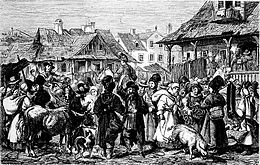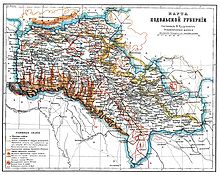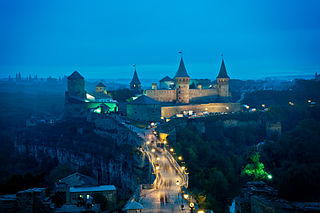
Podolia or Podilia is a historic region in Eastern Europe, located in the west-central and south-western parts of Ukraine and in northeastern Moldova.
A governorate was a major and principal administrative subdivision of the Russian Empire. After the Bolshevik Revolution in 1917, governorates remained as subdivisions in the Byelorussian, Russian and Ukrainian Soviet republics, and in the Soviet Union from its formation in 1922 until 1929. The term is also translated as government or province. A governorate was headed by a governor, a word borrowed from Latin gubernator, in turn from Greek κυβερνήτης.

Bratslav is an urban-type settlement in Ukraine, located in Tulchyn Raion of Vinnytsia Oblast, by the Southern Bug river. It is a medieval European city and a regional center of the Eastern Podolia region founded by government of the Crown of the Kingdom of Poland, which dramatically lost its importance during the 19th-20th centuries. Population: 4,872

The Podolian Voivodeship or Palatinate of Podolia was a unit of administrative division and local government in the Kingdom of Poland, from 1434 until 1793, except for the period of Ottoman occupation (1672–1699), when the region was organized as Podolia Eyalet. Together with the Bracław Voivodeship it formed the region of Podolia, which in the Kingdom of Poland was part of Lesser Poland Province. Its capital was in Kamieniec Podolski, where local sejmiks took place and where the seat of the starosta was as well.
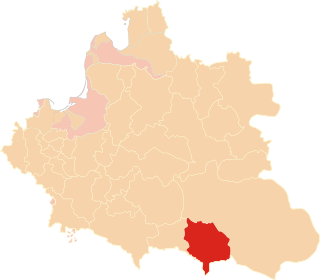
The Bracław Voivodeship was a unit of administrative division of the Polish–Lithuanian Commonwealth. Created in 1566 as part of the Grand Duchy of Lithuania, it was passed to the Kingdom of Poland in 1569 following the Union of Lublin. After Second Partition of Poland in 1793 the voivodeship was taken by the Russian Empire and replaced with the Bratslav Viceroyalty.

Kamianets-Podilskyi is a city on the Smotrych River in western Ukraine, to the north-east of Chernivtsi. Formerly the administrative center of Khmelnytskyi Oblast, the city is now the administrative center of Kamianets-Podilskyi Raion within the oblast. It hosts the administration of Kamianets-Podilskyi urban hromada. Population: 96,896.

Western Krai was an unofficial name for the westernmost parts of the Russian Empire, excluding the territory of Congress Poland. The term encompasses the lands annexed by the Russian Empire in the successive partitions of the Polish–Lithuanian Commonwealth in the late 18th century – in 1772, 1793, 1795 and located east of Congress Poland. This area is known in Poland as Ziemie Zabrane but is most often referred to in Polish historiography and common parlance as part of Zabór Rosyjski. Together with Bessarabia and the former Crimean Khanate, the territory roughly overlapped also with the Jewish Pale of Settlement of the Russian Empire, and included much of what is today Belarus, Ukraine, and Lithuania.

Tulchyn is a city in Vinnytsia Oblast (province) of western Ukraine, in the historical region of Podolia. It is the administrative center of Tulchyn Raion (district). Its population is 14,446.

Kherson Governorate, known until 1803 as Nikolayev Governorate, was an administrative-territorial unit (guberniya) of the Russian Empire, with its capital in Kherson. It encompassed 71,936 square kilometres (27,775 sq mi) in area and had a population of 2,733,612 inhabitants. At the time of the census in 1897, it bordered Podolia Governorate to the northwest, Kiev Governorate to the north, Poltava Governorate to the northeast, Yekaterinoslav Governorate to the east, Taurida Governorate to the southeast, Black Sea to the south, and Bessarabia Governorate to the west. It roughly corresponds to what is now most of Mykolaiv, Kirovohrad and Odesa Oblasts in Ukraine and some parts of Kherson and Dnipropetrovsk Oblasts.

Haisyn or Haysyn is a city in central Ukraine. It serves as the administrative center of Haisyn Raion within Vinnytsia Oblast. It is located on the Sob in the eastern part of the historical region of Podolia. Its population is 25,698.

Following three consecutive partitions of Poland carried out between 1772 and 1795, the sovereign state known as the Polish–Lithuanian Commonwealth disappeared from the map of Europe. In 1918 following the end of World War I, the territories of the former state re-emerged as the states of Poland and Lithuania among others. In the intervening period, the territory of the former Polish–Lithuanian Commonwealth was split between the Austrian Empire, the Kingdom of Prussia and the Russian Empire. These powers subdivided the territories that they gained and created new toponyms for the territories conquered. The subdivisions created were complicated by changes within those empires as well as by the periodic establishment of other forms of the quasi-Polish provinces led by a foreign head of state.

The Russian Partition, sometimes called Russian Poland, constituted the former territories of the Polish–Lithuanian Commonwealth that were annexed by the Russian Empire in the course of late-18th-century Partitions of Poland. The Russian acquisition encompassed the largest share of Poland's population, living on 463,200 km2 of land constituting the eastern and central territory of the former commonwealth. The three partitions, which took place in 1772, 1793 and 1795, resulted in the complete loss of Poland's sovereignty, with its territory split between Russia, Prussia and Austria. The Napoleonic Wars saw significant parts of Prussia's and Austria's partitions reconstituted as the Duchy of Warsaw, most of which was then reconstituted as the Kingdom of Poland within the Russian Empire in 1815.

Volhynia Governorate, also known as Volyn Governorate, was an administrative-territorial unit (guberniya) of the Southwestern Krai of the Russian Empire. It consisted of an area of 71,736 square kilometres (27,697 sq mi) and a population of 2,989,482 inhabitants. The governorate bordered Grodno and Minsk Governorates to the north, Kiev Governorate to the east, Podolia Governorate to the south, Lublin and Siedlce Governorates, and after 1912, Kholm Governorate and Austria to the west. Its capital was in Novograd-Volynsky until 1804, and then Zhitomir. It corresponded to most of modern-day Volyn, Rivne and Zhytomyr Oblasts of Ukraine and some parts of Brest and Gomel Regions of Belarus.

Kiev Governorate was an administrative-territorial unit (guberniya) of the Russian Empire from 1796 to 1919 and the Ukrainian Soviet Socialist Republic from 1919 to 1925. It included the territory of the right-bank Ukraine and was formed after a division of the Kiev Viceroyalty into Kiev and Little Russia Governorates in 1796. Its capital was in Kiev. By the early 20th century, it consisted of 12 uyezds, 12 cities, 111 miasteczkos and 7344 other settlements. After the October Revolution, it became part of the administrative division of the Ukrainian SSR. In 1923 it was divided into several okrugs and on 6 June 1925 it was abolished by the Soviet administrative reforms.

During its existence from 1919 to 1991, the Ukrainian Soviet Socialist Republic consisted of many administrative divisions. Itself part of the highly centralized Soviet Union, sub-national divisions in the Ukrainian SSR were subordinate to higher executive authorities and derived their power from them. Throughout the Ukrainian SSR's history, other national subdivisions were established in the republic, including guberniyas and okrugs, before finally being reorganized into their present structure as oblasts. At the time of the Ukrainian SSR's independence from the Soviet Union, the country was composed of 25 oblasts (provinces) and two cities with special status, Kiev, the capital, and Sevastopol, respectively.
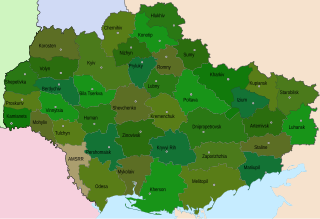
An okruha is a historical administrative division of the Ukrainian Soviet Socialist Republic that existed between 1923 and 1930. The system was intended as a transitional system between the Russian Imperial division of governorates and the modern equivalent of oblasts.
Kamianets Okruha was one of the administrative units of the Ukrainian Soviet Socialist Republic from 1923–1930 and again from 1935–1937.

The Kamenets-Podolsky uezd was a county (uezd) of the Podolian Governorate of the Russian Empire. The uezd bordered the Proskurov uezd to the north, the Ushitsa uezd to the east, the Khotin uezd to the south, and Austria to the west. Its administrative centre of the county was Kamenets-Podolsky. The county covered most of the area of Kamianets-Podilskyi Raion.

The Proskurov uezd was a county (uezd) of the Podolia Governorate of the Russian Empire, with its administrative centre in Proskurov. It border the Starokonstantinov uezd of the Volhynian Governorate to the north, the Letichev uezd to the east, the Kamenets-Podolsky uezd to the south, and Austria to the west. The area of the uezd covered most of Ukraine's Khmelnytskyi Raion.

The Ushitsa uezd was a county (uezd) of the Podolia Governorate of the Russian Empire. The uezd bordered Letichev uezd to the north, the Mogilev uezd to the east, the Khotin uezd of the Bessarabia Governorate to the south, and the Kamenets-Podolsky uezd to the west. It included most of Kamianets-Podilskyi Raion of Ukraine. The district was eponymously named for its administrative center, Novaya Ushitsa.


